University Finance Report: a2 Milk Company Financial Analysis
VerifiedAdded on 2023/04/23
|8
|1323
|327
Report
AI Summary
This finance report analyzes the financial position of the a2 Milk Company, focusing on the year ended 2016. It examines the company's bad debt expenses, specifically the $69,000 recorded, and the allowance method used. The report calculates and interprets key financial ratios such as net profit margin, current ratio, and debt-equity ratio to assess the company's liquidity, profitability, and solvency. The analysis includes charts illustrating sales and net profit trends, leading to an evaluation of the company's sustainability. The report concludes with recommendations for investment, suggesting the company should prioritize equity financing over debt to enhance its leverage position. The report uses information from the company's annual report and relevant financial literature to support its findings.
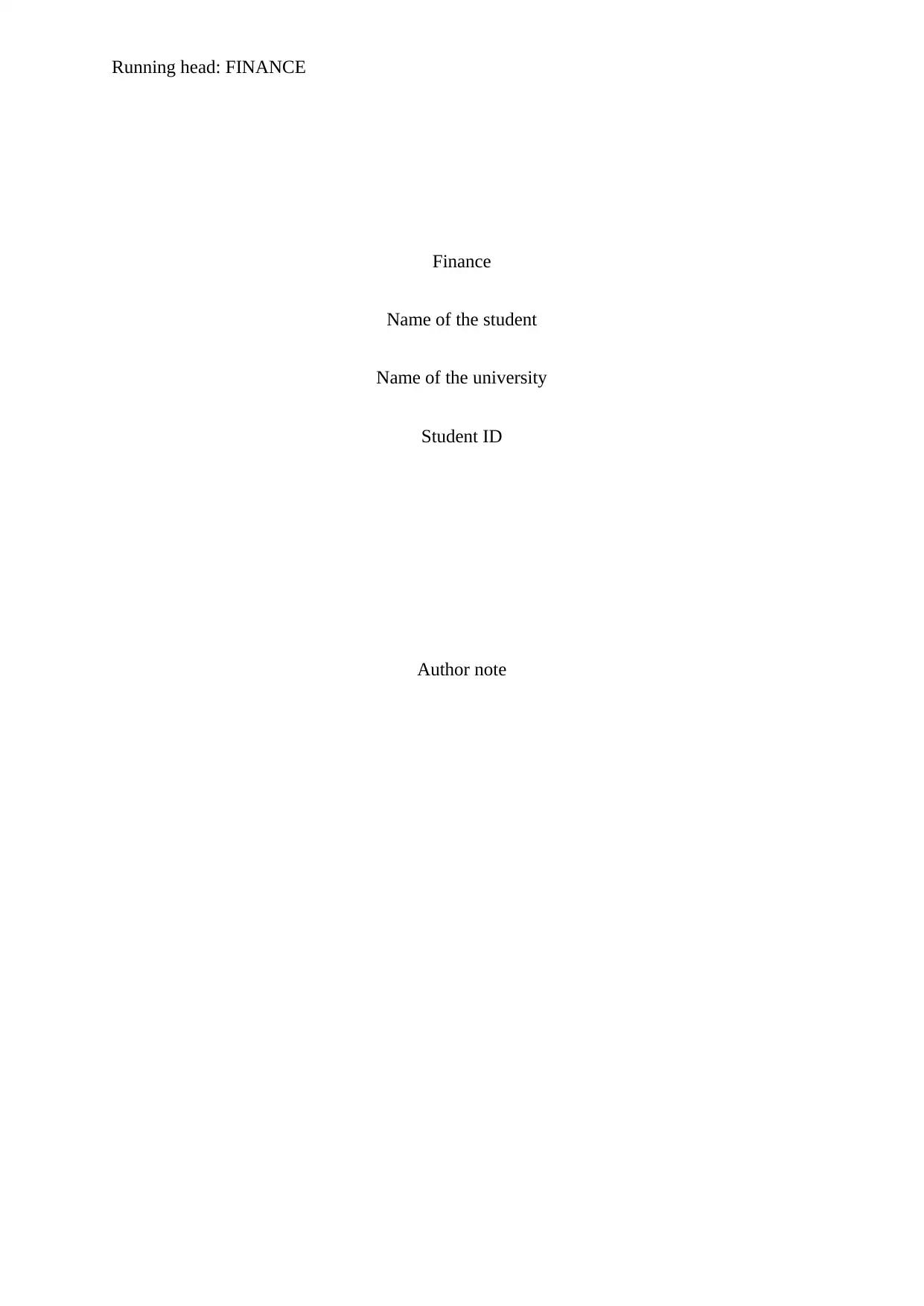
Running head: FINANCE
Finance
Name of the student
Name of the university
Student ID
Author note
Finance
Name of the student
Name of the university
Student ID
Author note
Paraphrase This Document
Need a fresh take? Get an instant paraphrase of this document with our AI Paraphraser
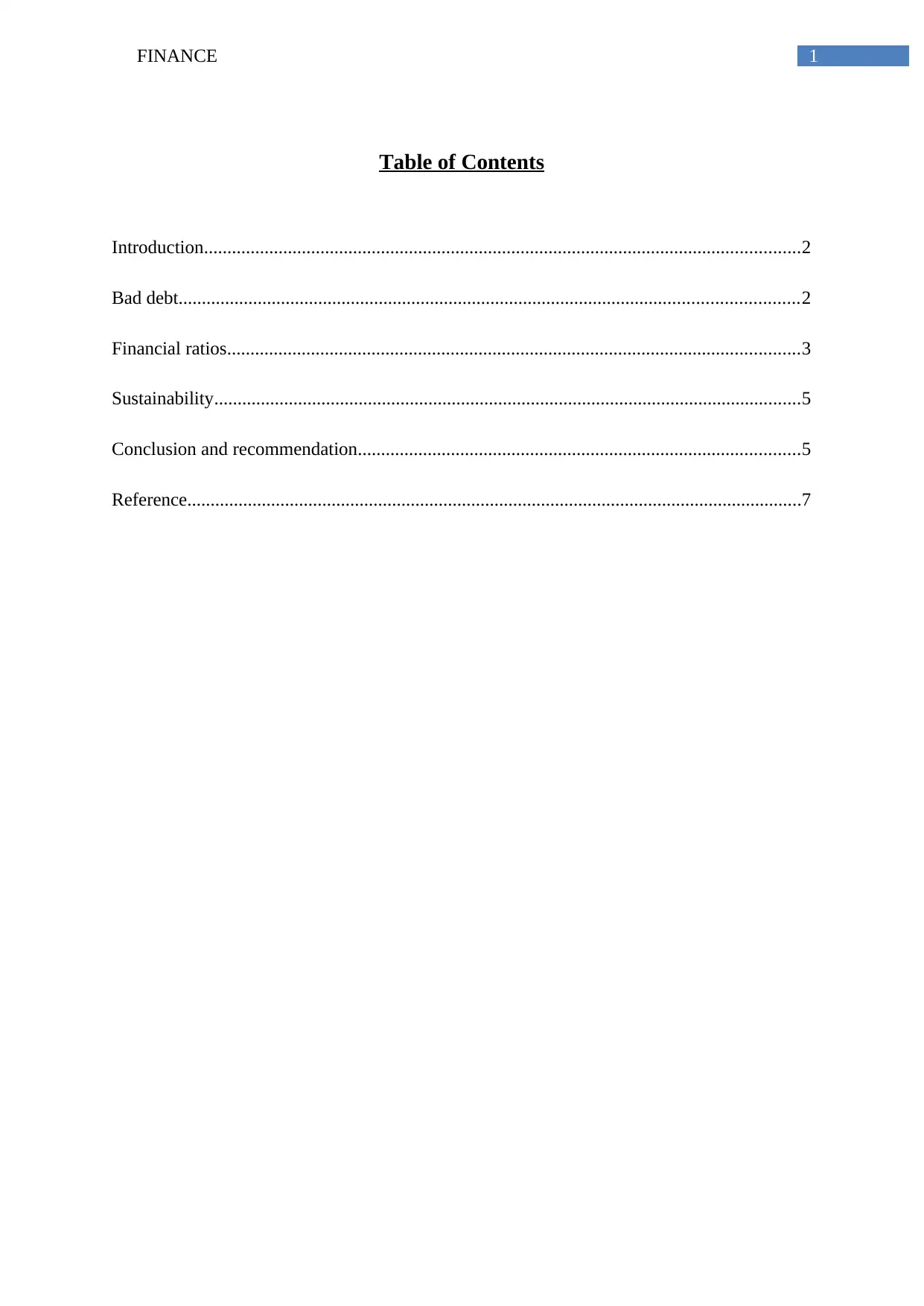
1FINANCE
Table of Contents
Introduction................................................................................................................................2
Bad debt.....................................................................................................................................2
Financial ratios...........................................................................................................................3
Sustainability..............................................................................................................................5
Conclusion and recommendation...............................................................................................5
Reference....................................................................................................................................7
Table of Contents
Introduction................................................................................................................................2
Bad debt.....................................................................................................................................2
Financial ratios...........................................................................................................................3
Sustainability..............................................................................................................................5
Conclusion and recommendation...............................................................................................5
Reference....................................................................................................................................7
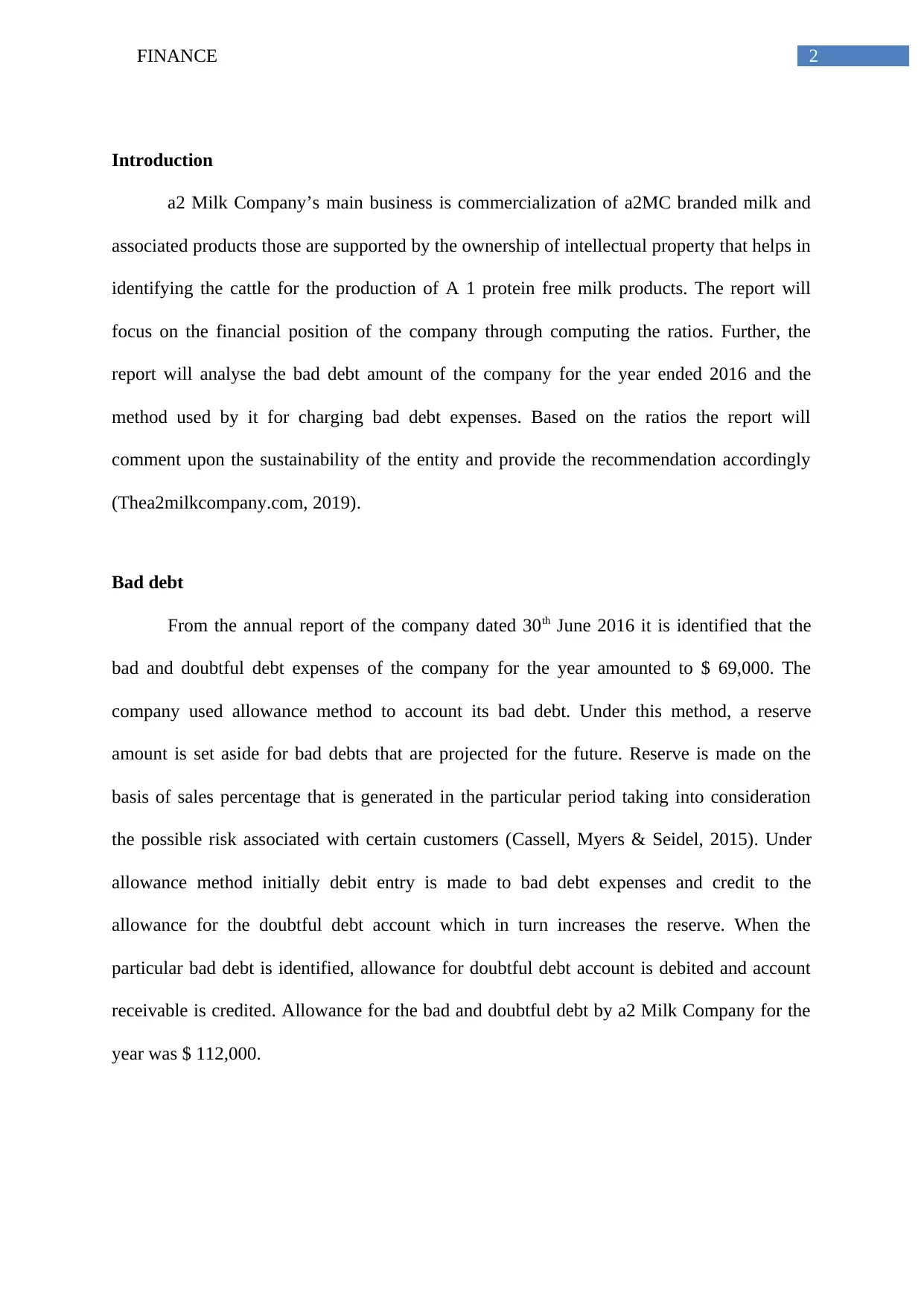
2FINANCE
Introduction
a2 Milk Company’s main business is commercialization of a2MC branded milk and
associated products those are supported by the ownership of intellectual property that helps in
identifying the cattle for the production of A 1 protein free milk products. The report will
focus on the financial position of the company through computing the ratios. Further, the
report will analyse the bad debt amount of the company for the year ended 2016 and the
method used by it for charging bad debt expenses. Based on the ratios the report will
comment upon the sustainability of the entity and provide the recommendation accordingly
(Thea2milkcompany.com, 2019).
Bad debt
From the annual report of the company dated 30th June 2016 it is identified that the
bad and doubtful debt expenses of the company for the year amounted to $ 69,000. The
company used allowance method to account its bad debt. Under this method, a reserve
amount is set aside for bad debts that are projected for the future. Reserve is made on the
basis of sales percentage that is generated in the particular period taking into consideration
the possible risk associated with certain customers (Cassell, Myers & Seidel, 2015). Under
allowance method initially debit entry is made to bad debt expenses and credit to the
allowance for the doubtful debt account which in turn increases the reserve. When the
particular bad debt is identified, allowance for doubtful debt account is debited and account
receivable is credited. Allowance for the bad and doubtful debt by a2 Milk Company for the
year was $ 112,000.
Introduction
a2 Milk Company’s main business is commercialization of a2MC branded milk and
associated products those are supported by the ownership of intellectual property that helps in
identifying the cattle for the production of A 1 protein free milk products. The report will
focus on the financial position of the company through computing the ratios. Further, the
report will analyse the bad debt amount of the company for the year ended 2016 and the
method used by it for charging bad debt expenses. Based on the ratios the report will
comment upon the sustainability of the entity and provide the recommendation accordingly
(Thea2milkcompany.com, 2019).
Bad debt
From the annual report of the company dated 30th June 2016 it is identified that the
bad and doubtful debt expenses of the company for the year amounted to $ 69,000. The
company used allowance method to account its bad debt. Under this method, a reserve
amount is set aside for bad debts that are projected for the future. Reserve is made on the
basis of sales percentage that is generated in the particular period taking into consideration
the possible risk associated with certain customers (Cassell, Myers & Seidel, 2015). Under
allowance method initially debit entry is made to bad debt expenses and credit to the
allowance for the doubtful debt account which in turn increases the reserve. When the
particular bad debt is identified, allowance for doubtful debt account is debited and account
receivable is credited. Allowance for the bad and doubtful debt by a2 Milk Company for the
year was $ 112,000.
⊘ This is a preview!⊘
Do you want full access?
Subscribe today to unlock all pages.

Trusted by 1+ million students worldwide
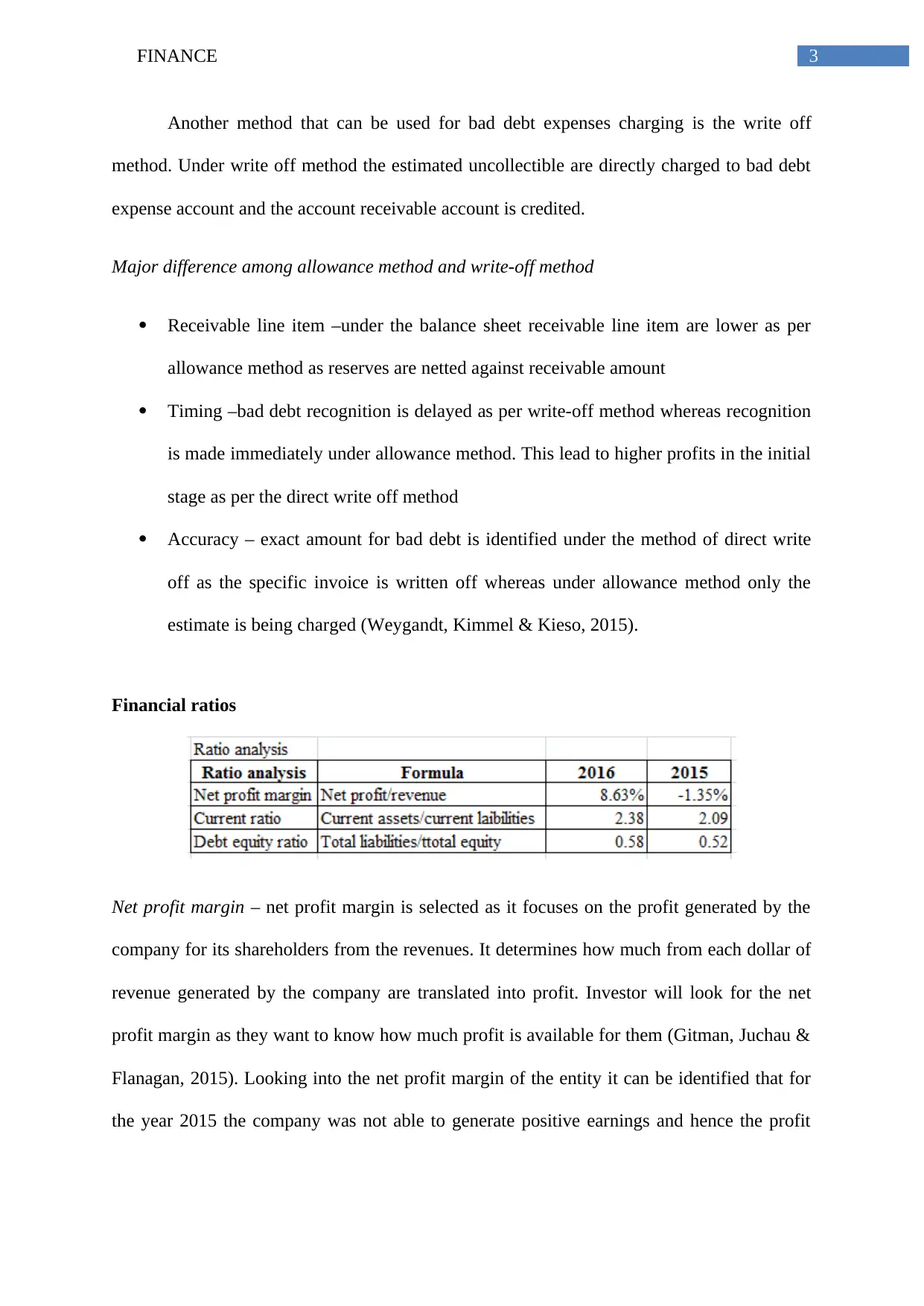
3FINANCE
Another method that can be used for bad debt expenses charging is the write off
method. Under write off method the estimated uncollectible are directly charged to bad debt
expense account and the account receivable account is credited.
Major difference among allowance method and write-off method
Receivable line item –under the balance sheet receivable line item are lower as per
allowance method as reserves are netted against receivable amount
Timing –bad debt recognition is delayed as per write-off method whereas recognition
is made immediately under allowance method. This lead to higher profits in the initial
stage as per the direct write off method
Accuracy – exact amount for bad debt is identified under the method of direct write
off as the specific invoice is written off whereas under allowance method only the
estimate is being charged (Weygandt, Kimmel & Kieso, 2015).
Financial ratios
Net profit margin – net profit margin is selected as it focuses on the profit generated by the
company for its shareholders from the revenues. It determines how much from each dollar of
revenue generated by the company are translated into profit. Investor will look for the net
profit margin as they want to know how much profit is available for them (Gitman, Juchau &
Flanagan, 2015). Looking into the net profit margin of the entity it can be identified that for
the year 2015 the company was not able to generate positive earnings and hence the profit
Another method that can be used for bad debt expenses charging is the write off
method. Under write off method the estimated uncollectible are directly charged to bad debt
expense account and the account receivable account is credited.
Major difference among allowance method and write-off method
Receivable line item –under the balance sheet receivable line item are lower as per
allowance method as reserves are netted against receivable amount
Timing –bad debt recognition is delayed as per write-off method whereas recognition
is made immediately under allowance method. This lead to higher profits in the initial
stage as per the direct write off method
Accuracy – exact amount for bad debt is identified under the method of direct write
off as the specific invoice is written off whereas under allowance method only the
estimate is being charged (Weygandt, Kimmel & Kieso, 2015).
Financial ratios
Net profit margin – net profit margin is selected as it focuses on the profit generated by the
company for its shareholders from the revenues. It determines how much from each dollar of
revenue generated by the company are translated into profit. Investor will look for the net
profit margin as they want to know how much profit is available for them (Gitman, Juchau &
Flanagan, 2015). Looking into the net profit margin of the entity it can be identified that for
the year 2015 the company was not able to generate positive earnings and hence the profit
Paraphrase This Document
Need a fresh take? Get an instant paraphrase of this document with our AI Paraphraser
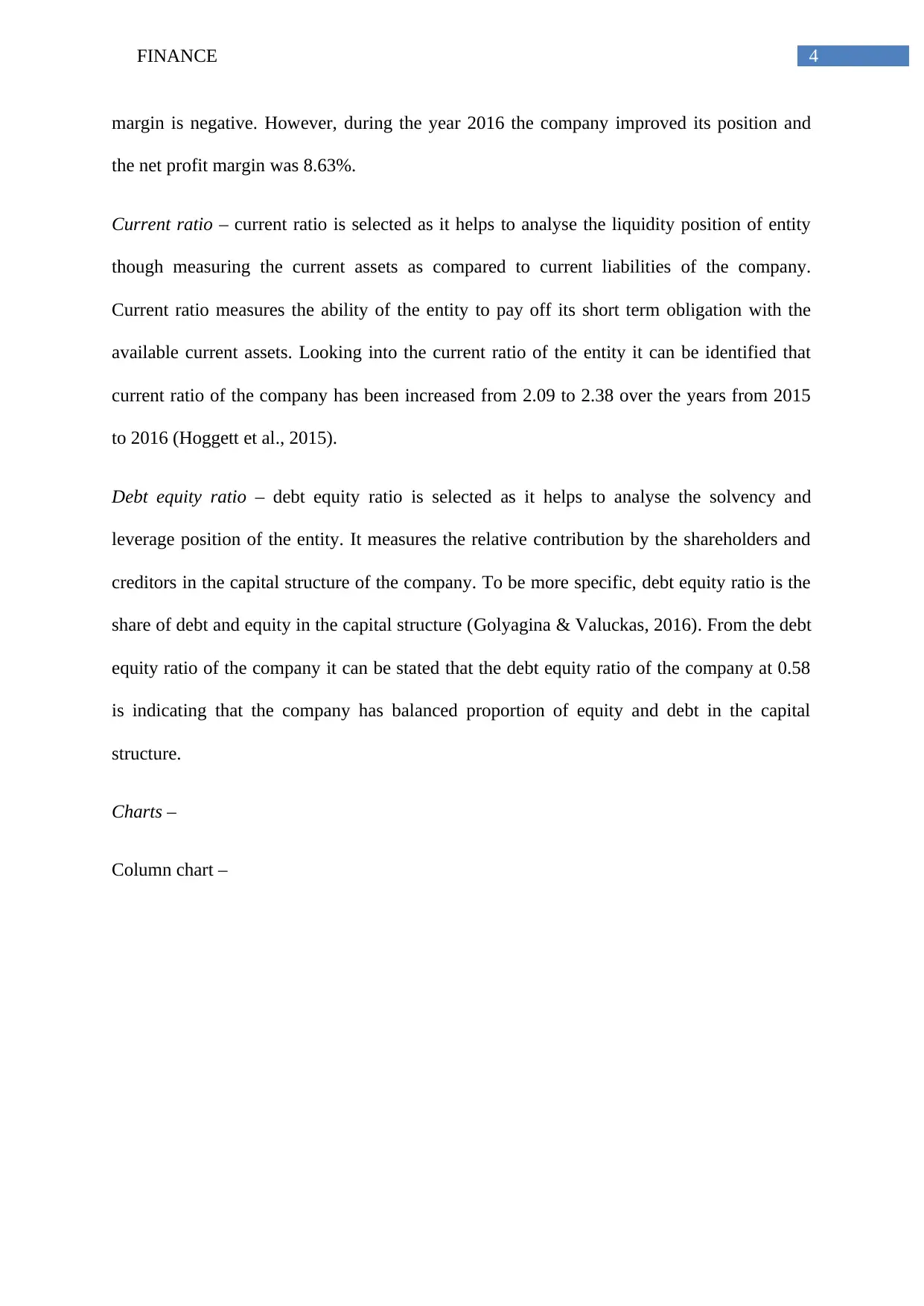
4FINANCE
margin is negative. However, during the year 2016 the company improved its position and
the net profit margin was 8.63%.
Current ratio – current ratio is selected as it helps to analyse the liquidity position of entity
though measuring the current assets as compared to current liabilities of the company.
Current ratio measures the ability of the entity to pay off its short term obligation with the
available current assets. Looking into the current ratio of the entity it can be identified that
current ratio of the company has been increased from 2.09 to 2.38 over the years from 2015
to 2016 (Hoggett et al., 2015).
Debt equity ratio – debt equity ratio is selected as it helps to analyse the solvency and
leverage position of the entity. It measures the relative contribution by the shareholders and
creditors in the capital structure of the company. To be more specific, debt equity ratio is the
share of debt and equity in the capital structure (Golyagina & Valuckas, 2016). From the debt
equity ratio of the company it can be stated that the debt equity ratio of the company at 0.58
is indicating that the company has balanced proportion of equity and debt in the capital
structure.
Charts –
Column chart –
margin is negative. However, during the year 2016 the company improved its position and
the net profit margin was 8.63%.
Current ratio – current ratio is selected as it helps to analyse the liquidity position of entity
though measuring the current assets as compared to current liabilities of the company.
Current ratio measures the ability of the entity to pay off its short term obligation with the
available current assets. Looking into the current ratio of the entity it can be identified that
current ratio of the company has been increased from 2.09 to 2.38 over the years from 2015
to 2016 (Hoggett et al., 2015).
Debt equity ratio – debt equity ratio is selected as it helps to analyse the solvency and
leverage position of the entity. It measures the relative contribution by the shareholders and
creditors in the capital structure of the company. To be more specific, debt equity ratio is the
share of debt and equity in the capital structure (Golyagina & Valuckas, 2016). From the debt
equity ratio of the company it can be stated that the debt equity ratio of the company at 0.58
is indicating that the company has balanced proportion of equity and debt in the capital
structure.
Charts –
Column chart –
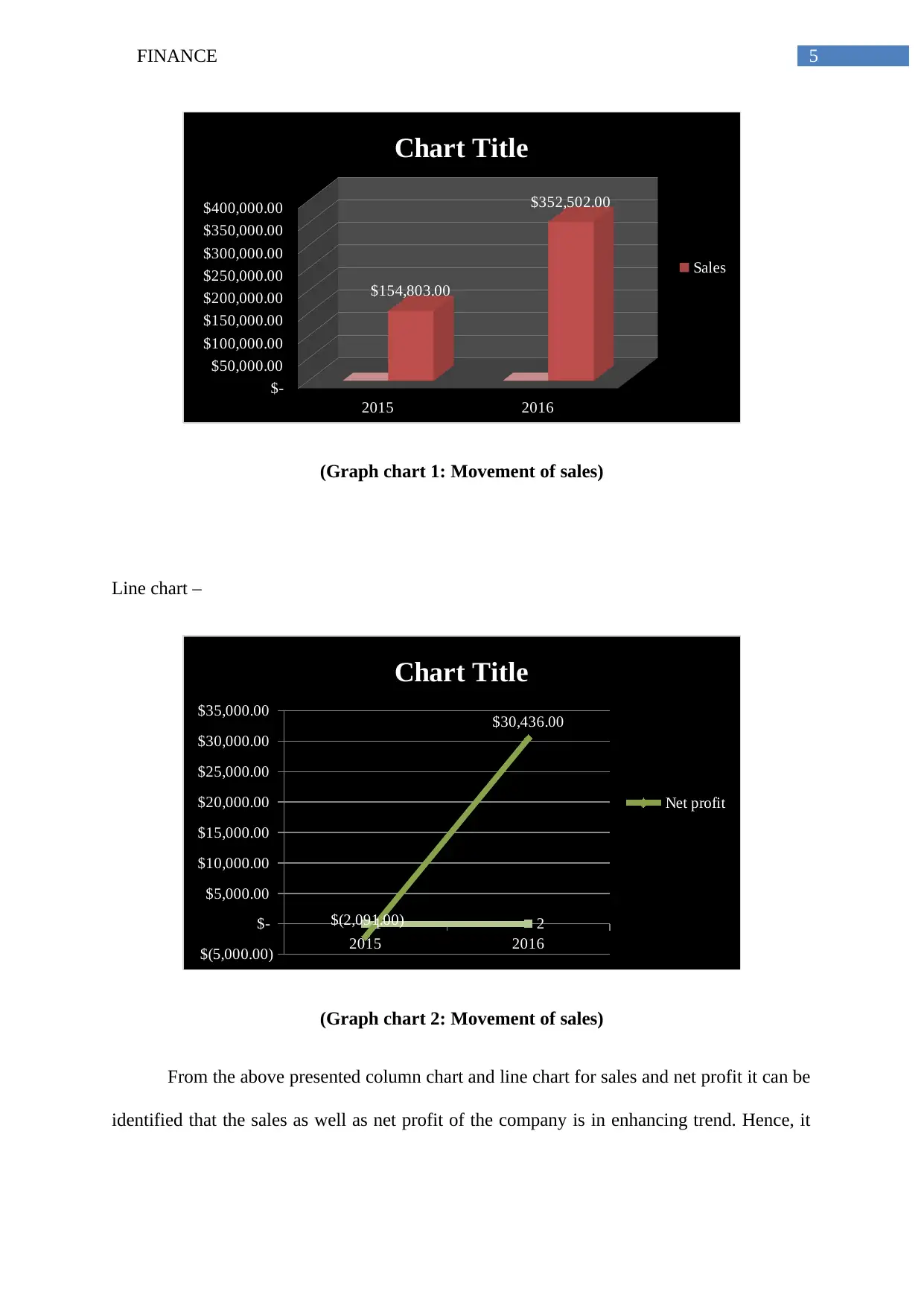
5FINANCE
2015 2016
$-
$50,000.00
$100,000.00
$150,000.00
$200,000.00
$250,000.00
$300,000.00
$350,000.00
$400,000.00
$154,803.00
$352,502.00
Chart Title
Sales
(Graph chart 1: Movement of sales)
Line chart –
2015 2016
$(5,000.00)
$-
$5,000.00
$10,000.00
$15,000.00
$20,000.00
$25,000.00
$30,000.00
$35,000.00
1 2$(2,091.00)
$30,436.00
Chart Title
Net profit
(Graph chart 2: Movement of sales)
From the above presented column chart and line chart for sales and net profit it can be
identified that the sales as well as net profit of the company is in enhancing trend. Hence, it
2015 2016
$-
$50,000.00
$100,000.00
$150,000.00
$200,000.00
$250,000.00
$300,000.00
$350,000.00
$400,000.00
$154,803.00
$352,502.00
Chart Title
Sales
(Graph chart 1: Movement of sales)
Line chart –
2015 2016
$(5,000.00)
$-
$5,000.00
$10,000.00
$15,000.00
$20,000.00
$25,000.00
$30,000.00
$35,000.00
1 2$(2,091.00)
$30,436.00
Chart Title
Net profit
(Graph chart 2: Movement of sales)
From the above presented column chart and line chart for sales and net profit it can be
identified that the sales as well as net profit of the company is in enhancing trend. Hence, it
⊘ This is a preview!⊘
Do you want full access?
Subscribe today to unlock all pages.

Trusted by 1+ million students worldwide
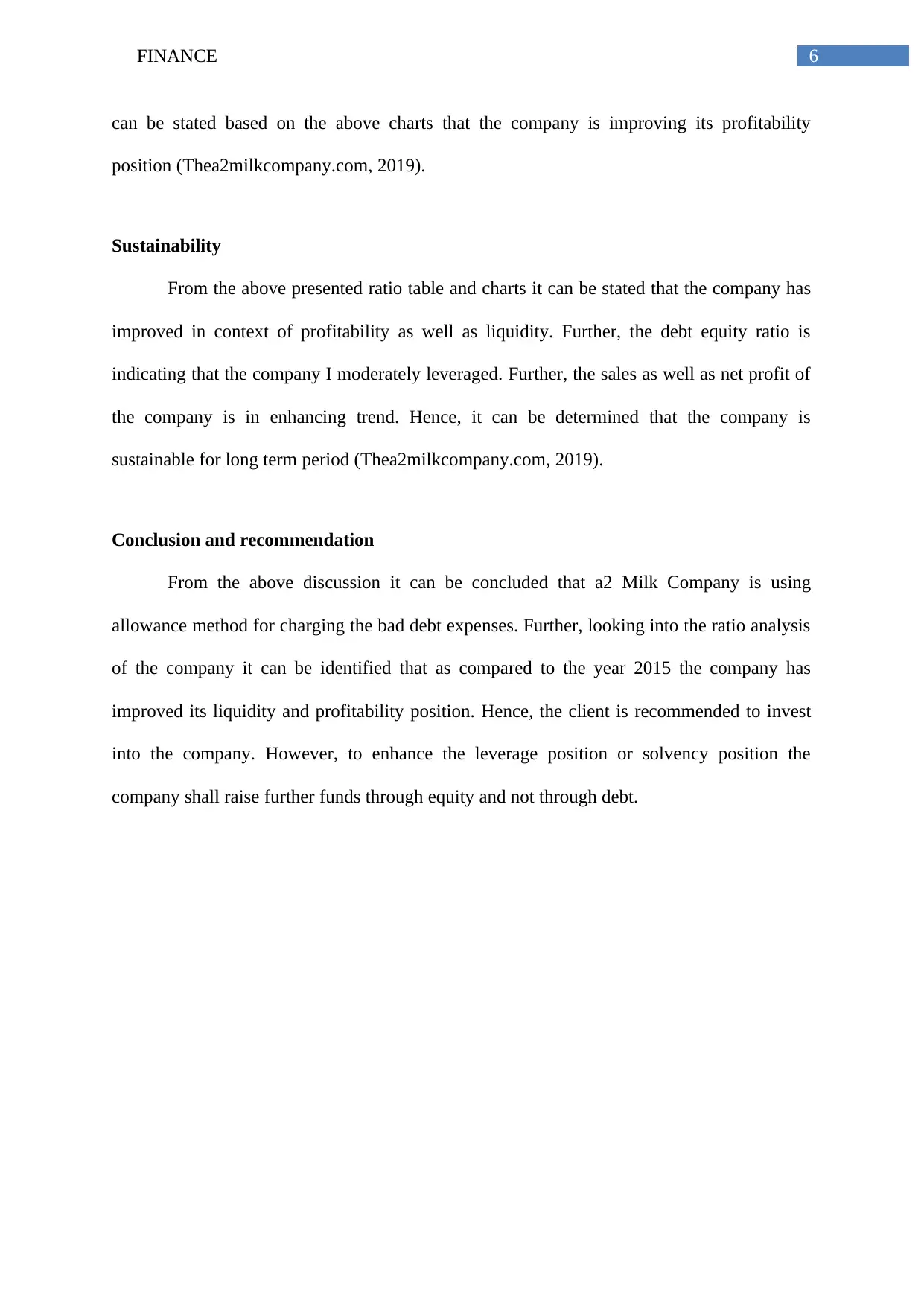
6FINANCE
can be stated based on the above charts that the company is improving its profitability
position (Thea2milkcompany.com, 2019).
Sustainability
From the above presented ratio table and charts it can be stated that the company has
improved in context of profitability as well as liquidity. Further, the debt equity ratio is
indicating that the company I moderately leveraged. Further, the sales as well as net profit of
the company is in enhancing trend. Hence, it can be determined that the company is
sustainable for long term period (Thea2milkcompany.com, 2019).
Conclusion and recommendation
From the above discussion it can be concluded that a2 Milk Company is using
allowance method for charging the bad debt expenses. Further, looking into the ratio analysis
of the company it can be identified that as compared to the year 2015 the company has
improved its liquidity and profitability position. Hence, the client is recommended to invest
into the company. However, to enhance the leverage position or solvency position the
company shall raise further funds through equity and not through debt.
can be stated based on the above charts that the company is improving its profitability
position (Thea2milkcompany.com, 2019).
Sustainability
From the above presented ratio table and charts it can be stated that the company has
improved in context of profitability as well as liquidity. Further, the debt equity ratio is
indicating that the company I moderately leveraged. Further, the sales as well as net profit of
the company is in enhancing trend. Hence, it can be determined that the company is
sustainable for long term period (Thea2milkcompany.com, 2019).
Conclusion and recommendation
From the above discussion it can be concluded that a2 Milk Company is using
allowance method for charging the bad debt expenses. Further, looking into the ratio analysis
of the company it can be identified that as compared to the year 2015 the company has
improved its liquidity and profitability position. Hence, the client is recommended to invest
into the company. However, to enhance the leverage position or solvency position the
company shall raise further funds through equity and not through debt.
Paraphrase This Document
Need a fresh take? Get an instant paraphrase of this document with our AI Paraphraser
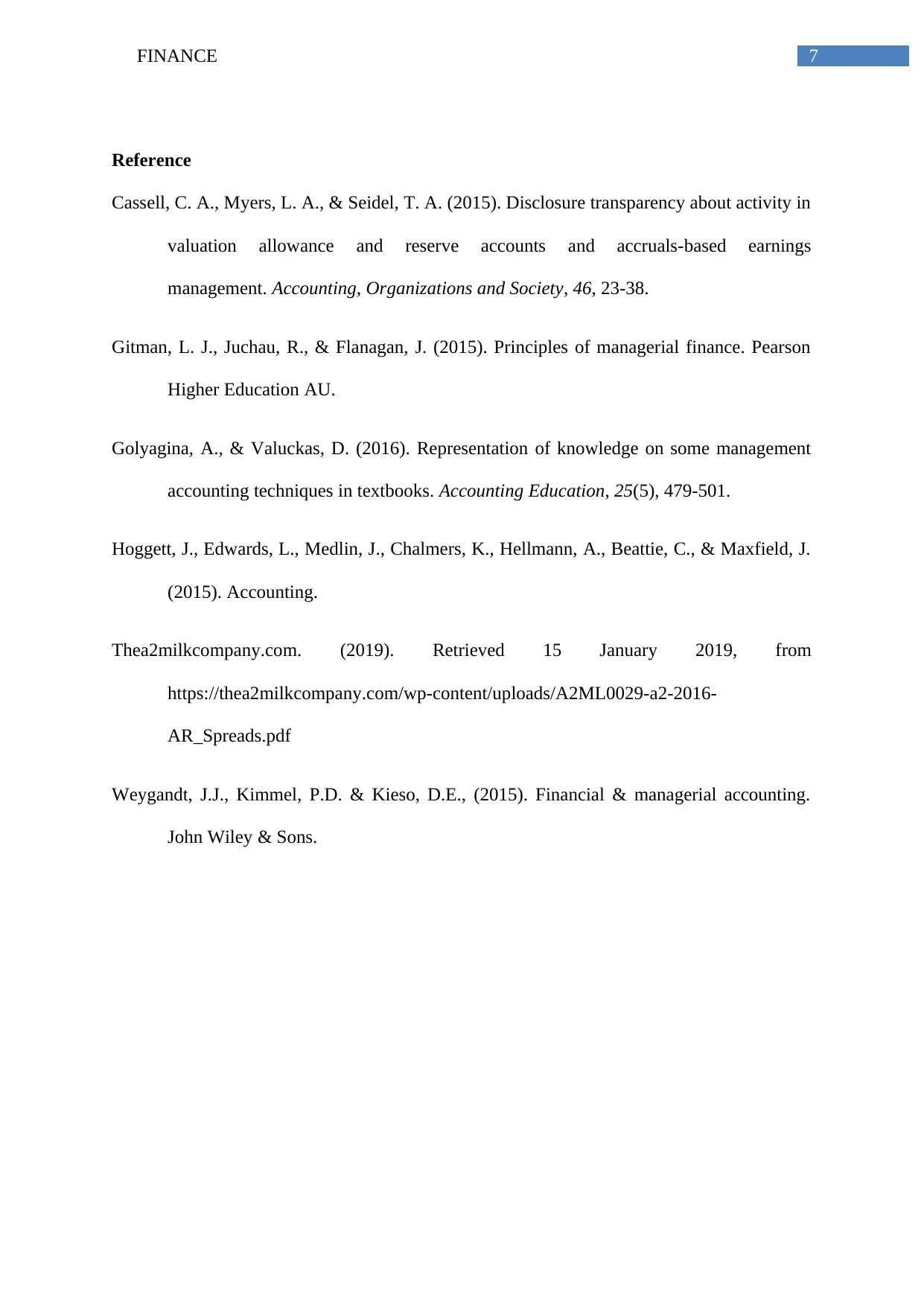
7FINANCE
Reference
Cassell, C. A., Myers, L. A., & Seidel, T. A. (2015). Disclosure transparency about activity in
valuation allowance and reserve accounts and accruals-based earnings
management. Accounting, Organizations and Society, 46, 23-38.
Gitman, L. J., Juchau, R., & Flanagan, J. (2015). Principles of managerial finance. Pearson
Higher Education AU.
Golyagina, A., & Valuckas, D. (2016). Representation of knowledge on some management
accounting techniques in textbooks. Accounting Education, 25(5), 479-501.
Hoggett, J., Edwards, L., Medlin, J., Chalmers, K., Hellmann, A., Beattie, C., & Maxfield, J.
(2015). Accounting.
Thea2milkcompany.com. (2019). Retrieved 15 January 2019, from
https://thea2milkcompany.com/wp-content/uploads/A2ML0029-a2-2016-
AR_Spreads.pdf
Weygandt, J.J., Kimmel, P.D. & Kieso, D.E., (2015). Financial & managerial accounting.
John Wiley & Sons.
Reference
Cassell, C. A., Myers, L. A., & Seidel, T. A. (2015). Disclosure transparency about activity in
valuation allowance and reserve accounts and accruals-based earnings
management. Accounting, Organizations and Society, 46, 23-38.
Gitman, L. J., Juchau, R., & Flanagan, J. (2015). Principles of managerial finance. Pearson
Higher Education AU.
Golyagina, A., & Valuckas, D. (2016). Representation of knowledge on some management
accounting techniques in textbooks. Accounting Education, 25(5), 479-501.
Hoggett, J., Edwards, L., Medlin, J., Chalmers, K., Hellmann, A., Beattie, C., & Maxfield, J.
(2015). Accounting.
Thea2milkcompany.com. (2019). Retrieved 15 January 2019, from
https://thea2milkcompany.com/wp-content/uploads/A2ML0029-a2-2016-
AR_Spreads.pdf
Weygandt, J.J., Kimmel, P.D. & Kieso, D.E., (2015). Financial & managerial accounting.
John Wiley & Sons.
1 out of 8
Related Documents
Your All-in-One AI-Powered Toolkit for Academic Success.
+13062052269
info@desklib.com
Available 24*7 on WhatsApp / Email
![[object Object]](/_next/static/media/star-bottom.7253800d.svg)
Unlock your academic potential
Copyright © 2020–2025 A2Z Services. All Rights Reserved. Developed and managed by ZUCOL.





